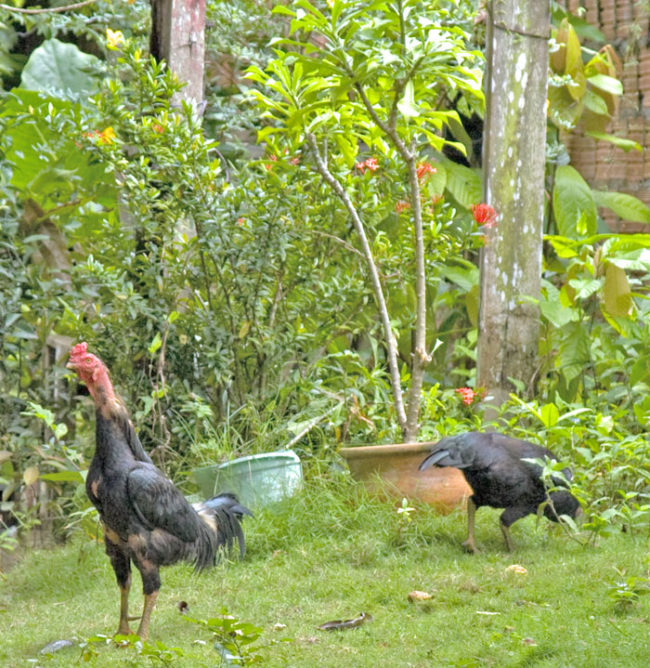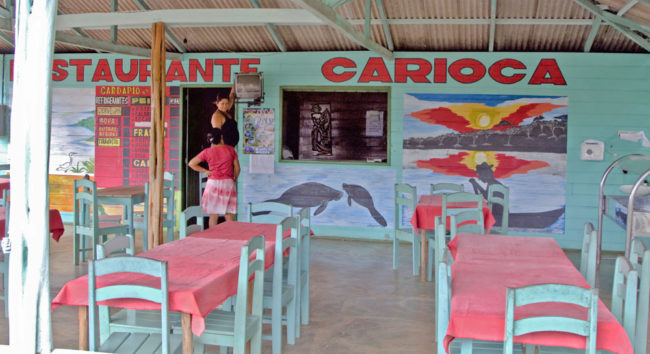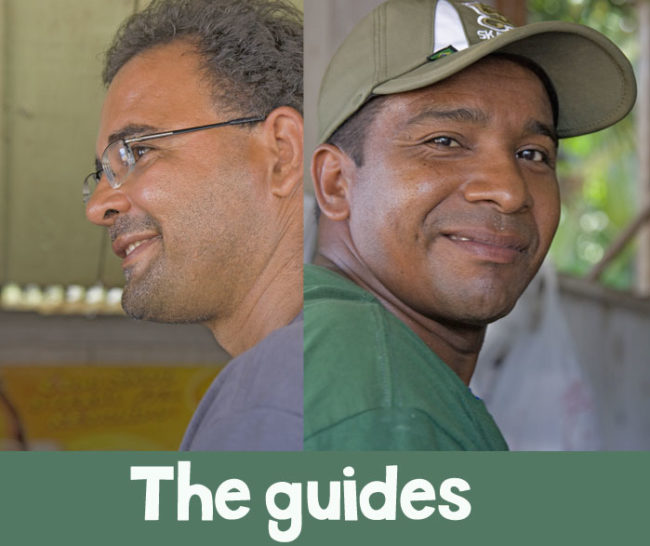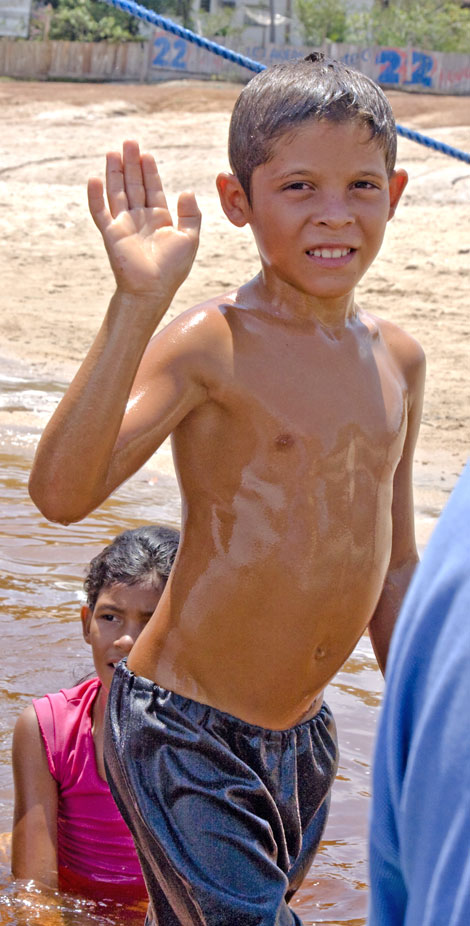Second day in the Amazon–town tour and art school
We thanked the dolphin lady, me at the time having no idea that she was a shill for a couple of new-money aristocrats (thanks for the scenario, Robocop!). Our boat driver stayed behind, while Cassio assembled us and directed us to go with him. We headed toward the main downtown strip, which consisted of a couple of art shops, a couple of bars, and a couple of other enterprises, some closed.
Cassio led us into one of the first art shops on the left. I had it in my mind that I wanted to buy one of the wooden frogs that you use to make clicking percussion with. They had one at the lodge, and Yavor and I were playing with it the night before. The stick comes out and you use it to rub over the spines. It’s very cool.
 The shop had several, and they were, like 30 Reais each. I immediately bought a frog, not knowing that we were going to the motherlode of frogs in a little bit. So of course, I paid the inflated “gallery” price. I felt like a sap when I found out, then immediately felt like an asshole for pining over 5 Reais. In retrospect, however, I got the best frog in the city, being made from so many different kinds of wood. There weren’t any quite as elaborate anywhere else.
The shop had several, and they were, like 30 Reais each. I immediately bought a frog, not knowing that we were going to the motherlode of frogs in a little bit. So of course, I paid the inflated “gallery” price. I felt like a sap when I found out, then immediately felt like an asshole for pining over 5 Reais. In retrospect, however, I got the best frog in the city, being made from so many different kinds of wood. There weren’t any quite as elaborate anywhere else.
There was a genuine Amazonian bow and arrow that I had to try. I’d probably be able to hit a target, say, two feet away with THAT pull.

 After Robo bought a blow gun that exicted him to no end, we left the shop and followed Cassio up to what I would call Main Street, but which was, in actuality Avenue Presidente Getúlio Vargas. I wasn’t sure who he was, but he had the best residential real estate in town on his street.
After Robo bought a blow gun that exicted him to no end, we left the shop and followed Cassio up to what I would call Main Street, but which was, in actuality Avenue Presidente Getúlio Vargas. I wasn’t sure who he was, but he had the best residential real estate in town on his street.
The houses were really tiny and colorful. Most of them had electricity, so this was probably a very progressive Amazonian town. I never did get the name, but will find out.
 This was a pretty plush place, comparatively. They’re probably the ones that own the dolphin concession. Their neighbors were less plush. That is, unless the yellow house bought out the owners of the green house and now use it for a guest house. Who knows? Really? Would they have any kind of “society” structure here? A fascinating sociologial thought, considering we’re so gol-durned status conscious here in the U.S.
This was a pretty plush place, comparatively. They’re probably the ones that own the dolphin concession. Their neighbors were less plush. That is, unless the yellow house bought out the owners of the green house and now use it for a guest house. Who knows? Really? Would they have any kind of “society” structure here? A fascinating sociologial thought, considering we’re so gol-durned status conscious here in the U.S.


Some things are inescapable, but so much less offensive than others. I found this kind of quaint and refreshing in a “See Rock City” kind of way. Notice the “marcus reg.” on the logo. This was produced by somebody in authority. No intellectual ripoffs here.
This cluster of houses was kinda cool. What’s the little one in the front? The teenager’s pod? Who knows? I would have loved to. This whole world was unveiling itself to us on a rather annoying hill, and I started to become annoyingly suado and thirsty simultaneously.
 This was a thought-provoking shot: an empty lot with waterfront view. Did somebody own the lot? What if I went all crazy like Howard Sprague did on Andy Griffith, and decided to move to the Amazon. Could I just build me a house there? Would my big fat 2-to-1 American money get me anything I wanted there? How would the locals accept me? Would the ladies on Avenue Presidente Getúlio Vargas have some kind of tea for Jean and me? After all, it WAS the Mountain Brook Parkway of this village. WHAT WOULD HAPPEN? I know one thing: I’d capture every one of their souls with my devil box.
This was a thought-provoking shot: an empty lot with waterfront view. Did somebody own the lot? What if I went all crazy like Howard Sprague did on Andy Griffith, and decided to move to the Amazon. Could I just build me a house there? Would my big fat 2-to-1 American money get me anything I wanted there? How would the locals accept me? Would the ladies on Avenue Presidente Getúlio Vargas have some kind of tea for Jean and me? After all, it WAS the Mountain Brook Parkway of this village. WHAT WOULD HAPPEN? I know one thing: I’d capture every one of their souls with my devil box.
 The flora was beautiful on Avenue Presidente Getúlio Vargas, and the fauna was interesting as well.
The flora was beautiful on Avenue Presidente Getúlio Vargas, and the fauna was interesting as well.



We finally reached the top of the hill and took a right onto another commercial street. This was populated by a transmissão shop and a restaurant that billed itself as “carioca.” Was this to attract the people from Rio? Was this an effort to be cosmopolitan, because the cariocas are from Rio, and Rio is hot and glitzy and modern? Is it the equivalent of having a place off Interstate 65 in Thorsby called “New York Bistro”?
 This place is called Toca do Gordo. When I Babel Fished it, it said “It touches of the fat person.” So, maybe it’s supposed to be a restaurant/bodega that gives you more than your money’s worth? Or maybe “a touch of the fat” is an idiom for “luxurious” in Portuguese. I would suspect so. And here’s the Restaurante Carioca. Pretty colors. And notice they’re working on a TV for the patrons to watch.
This place is called Toca do Gordo. When I Babel Fished it, it said “It touches of the fat person.” So, maybe it’s supposed to be a restaurant/bodega that gives you more than your money’s worth? Or maybe “a touch of the fat” is an idiom for “luxurious” in Portuguese. I would suspect so. And here’s the Restaurante Carioca. Pretty colors. And notice they’re working on a TV for the patrons to watch.
 I was walking with Yavor most of the time, and got to know a little more about him. He had told us earlier that he wasn’t just a casual musician. He had a band called Jailhouse Chili, and his stage name was John Cool. I liked both names, and told him so. The name John Cool (which I changed to Johnny Cool for my own purposes) had just enough irony and retro appeal to it to be good in any language.
I was walking with Yavor most of the time, and got to know a little more about him. He had told us earlier that he wasn’t just a casual musician. He had a band called Jailhouse Chili, and his stage name was John Cool. I liked both names, and told him so. The name John Cool (which I changed to Johnny Cool for my own purposes) had just enough irony and retro appeal to it to be good in any language.
 We started talking about real estate in recreational areas, and he told me of the good values that could be had in Bulgaria on the North Sea. “But they are costing more and more every day,” he added. Nothing we weren’t familiar with in America. I may not remember correctly, but he indicated that 75 thousand would get you a decent North Sea house to call your own. But getting to the North Sea was another matter.
We started talking about real estate in recreational areas, and he told me of the good values that could be had in Bulgaria on the North Sea. “But they are costing more and more every day,” he added. Nothing we weren’t familiar with in America. I may not remember correctly, but he indicated that 75 thousand would get you a decent North Sea house to call your own. But getting to the North Sea was another matter.

We passed a couple of streets to the right that were also residential and very neat. Yavor was as hot for the views as I was and took a bunch of pictures with his small camera.
 We took the next right and went down about 100 yards before turning into a pair of stucco posts leading into the art studio. We had seen the work the night before at the lodge, because they had some of the homemade paper for sale. That was the first artist we ran into: one of the paper makers. The product was thick, cushiony, textural and lovely. Made the old fashioned way.
We took the next right and went down about 100 yards before turning into a pair of stucco posts leading into the art studio. We had seen the work the night before at the lodge, because they had some of the homemade paper for sale. That was the first artist we ran into: one of the paper makers. The product was thick, cushiony, textural and lovely. Made the old fashioned way.
 The paper studio was just one of the small buildings contained in the courtyard. They had begun to landscape it, and it was very pretty and serene. Cassio led us to a large open sided shed where the wood artists were at work.
The paper studio was just one of the small buildings contained in the courtyard. They had begun to landscape it, and it was very pretty and serene. Cassio led us to a large open sided shed where the wood artists were at work.
 There was a large water machine with a jug of bottled water on top that attracted me instantly. A neat stack of paper cups sat under it, just like at any office. I downed three or four cups, then found a shelf to put the cup on, knowing I’d use it again.
There was a large water machine with a jug of bottled water on top that attracted me instantly. A neat stack of paper cups sat under it, just like at any office. I downed three or four cups, then found a shelf to put the cup on, knowing I’d use it again.
Several different things were made in the studio, but they managed to keep the menu rather simple, which was probably smart. There were carvings of turtles, frogs, canoes (with paddle), sting rays, boxes, small tables that were easy to assemble, wood plates, and a few other things.
“Sweatshop!” you’re fuming. Not so! Each artist signs his work with a wood burner, and as the pieces are sold, the artist is paid directly. Part of the money goes to the studio, but the artists are actually earning based on their proliferation and quality of work. They have an incentive to be inventive and quality craftsmen. While we were there, the girl you see on the left was working on an incredible large wooden platter made of about 5 different woods. Pettus wanted it. The Indian woman wanted it. And they had to tell us it was already pre-sold. The girl seemed very proud. Particularly because she would sign the bottom, and possibly create a market for her work apart from the others.
 The gallery room was shelf after shelf, all covered with the carvings. Each one was different and had its own personality. It took Jean and me a long time to decide what to get. We already had the frog, made of five different woods. I had my eye on some turtles. We had to get a stingray, just because, plus it was less expensive. We were running out of money. Oops, but there was a canoe that was perfect. The paddle had the signature on it.
The gallery room was shelf after shelf, all covered with the carvings. Each one was different and had its own personality. It took Jean and me a long time to decide what to get. We already had the frog, made of five different woods. I had my eye on some turtles. We had to get a stingray, just because, plus it was less expensive. We were running out of money. Oops, but there was a canoe that was perfect. The paddle had the signature on it.


 How cool! There were several artists who were in a small catalogue that the school had printed. They were the emerging stars. But who paid for the wood? How did the school get there? From a government grant and private contributions. The wood? It is rescued from its former fate of burning. That’s right. All that beautiful Amazonian wood. . .if it couldn’t be used for building anymore, it was burned. It was now all brought to the studio, and they had shelves and shelves of it, lots of large pieces, and it was all gorgeous. Wow!
How cool! There were several artists who were in a small catalogue that the school had printed. They were the emerging stars. But who paid for the wood? How did the school get there? From a government grant and private contributions. The wood? It is rescued from its former fate of burning. That’s right. All that beautiful Amazonian wood. . .if it couldn’t be used for building anymore, it was burned. It was now all brought to the studio, and they had shelves and shelves of it, lots of large pieces, and it was all gorgeous. Wow!
I went in to look at the wood room, and was particularly enamored of this sign.
 It looks like the skull was getting fried before turning white. Totally cool.
It looks like the skull was getting fried before turning white. Totally cool.
I had to pee after all the water, and wandered out into the courtyard to find the sanitário. I was arrested by this flower first, which looked very much like something in the honeysuckle family.
 Standing outside the bathrooms looking at the flowers, I could hear Yavor singing inside. What a voice! I didn’t recognize what he was singing, and figured maybe he had written it. It wouldn’t have surprised me. He and Natacha were incredibly capable people.
Standing outside the bathrooms looking at the flowers, I could hear Yavor singing inside. What a voice! I didn’t recognize what he was singing, and figured maybe he had written it. It wouldn’t have surprised me. He and Natacha were incredibly capable people.
When I got back to the studio, Jean was admiring one of the little tables. I think it was about 100 Reais. We had to have it, since its pieces were all flat stackable and easily packable. Pretty, eh? I have a Yellow Submarine lava lamp on top of it in our house, but here it is, with the incredible teapot from Rio lurking in the background.
 Wow! That was great! Now we had to walk back. Shit. I couldn’t wait. I was already beginning to feel the beginnings of a gald coming on. Well, at least we could turn left out of the place and go down one or two blocks and pick up Vargas Avenue instead of having to go back up, over and retrace going back down Vargas. I started to go that way and Cassio said, “No, wrong way. Come this way.”
Wow! That was great! Now we had to walk back. Shit. I couldn’t wait. I was already beginning to feel the beginnings of a gald coming on. Well, at least we could turn left out of the place and go down one or two blocks and pick up Vargas Avenue instead of having to go back up, over and retrace going back down Vargas. I started to go that way and Cassio said, “No, wrong way. Come this way.”
“Why can’t we just go down a block or two and go over?” I asked him. I had seen two streets come out on Vargas that I knew would be these two streets.
“No, it won’t work,” he said. I figured he didn’t want us to go rudely trooping by a bunch of strange houses or knew some bad secret about my chosen route, so I followed the others and trudged up to the main street. As if to answer our prayers, a white cab drove by slowly and stopped upon Cassio’s signal.
“Does anybody want to ride?” Cassio asked.
“Hell yes, we do!” I hollered. Jean and I headed toward the stopped cab. “How much will it be?”
Cassio talked to the driver, whose wife was sitting in the front seat beside him. The rest of the cab was a large van back with a bench seat. “Two Reais each,” Cassio said.
“Done,” we said, and climbed in. The Indian family joined us, as did Natacha and Yavor. Cassio and the Kennemers decided to walk back to the boat.
The cab driver’s wife got in the back and crouched on the floor with no seat while the rest of us sat. 16 Reais for three blocks is pretty good. But I was glad they got it.
 Here’s a picture Natacha took of us and Yavor sitting in the way-back of the cab. He emailed them to me a few months after we had returned.
Here’s a picture Natacha took of us and Yavor sitting in the way-back of the cab. He emailed them to me a few months after we had returned.
 We arrived back at the boat place lickety split, and decided to sit at some tables outside a little bar. I ordered Jean and me a couple of beers, and the proprietor brought two behemoth bottles each in its own styrofoam cooler to the counter.
We arrived back at the boat place lickety split, and decided to sit at some tables outside a little bar. I ordered Jean and me a couple of beers, and the proprietor brought two behemoth bottles each in its own styrofoam cooler to the counter.
 At first Jean protested, only weakly, and before long we had finished both bottles. They were cold and delicious, and suddenly downtown looked even groovier, and the glow of our new purchases was even glowier.
At first Jean protested, only weakly, and before long we had finished both bottles. They were cold and delicious, and suddenly downtown looked even groovier, and the glow of our new purchases was even glowier.
 Here’s a great shot of the family followed by Natacha Downtown.
Here’s a great shot of the family followed by Natacha Downtown.


That one giant beer had made me feel kinda cozy, as my Aunt Titter says. Pretty soon Cassio and the rest of the gang returned.
 That’s when Yavor decided to get a coconut and drink the water. The barman was more than happy to oblige. Neither he nor Natacha were enamored of this particular coconut, and I was asked to have some. Ummmm.
That’s when Yavor decided to get a coconut and drink the water. The barman was more than happy to oblige. Neither he nor Natacha were enamored of this particular coconut, and I was asked to have some. Ummmm.
Look at Cassio chatting up Natacha. She’s definitely chat-uppable.
 It was time to get back in the boat and go back home. It was almost lunchtime! That big brewski had kicked up the ole appetite, and I was ready for whatever they had to dish out.
It was time to get back in the boat and go back home. It was almost lunchtime! That big brewski had kicked up the ole appetite, and I was ready for whatever they had to dish out.
On the way out, some of the kids were kind enough to let me capture their precious souls. Beautiful ain’t the word.


